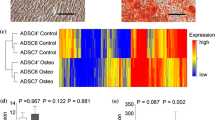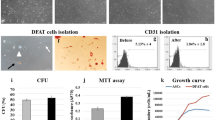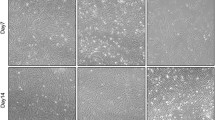Abstract
Adipose-derived stem cells (ADSCs) are stromal mesenchymal stem cells isolated from lipoaspirates, and they display a broad potential to differentiate toward different lineages. The role of epigenetics in regulating the expression of their lineage-specific genes is under evaluation, however till date virtually nothing is known about the relative significance of cardiac-specific transcription factor genes in human ADSCs. The aim of this study was to investigate DNA promoter methylation and relevant histone modifications involving MEF-2C, GATA-4, and Nkx2.5 in native human ADSCs. CpG sites at the transcription start in their promoters were found unmethylated using methylation-specific PCR. Chromatin immunoprecipitation assay showed low levels of total acetylated H3 histone (acH3) and high levels of trimethylated lysine 27 in H3 histone (H3K27me3) which were associated with both GATA-4 and Nkx2.5 promoters, indicating their transcriptional repressive chromatin arrangement. On the other hand, the opposite was apparent for MEF-2C promoter. Accordingly, MEF-2C—but not GATA-4 and Nkx2.5—transcripts were evidenced in native human ADSCs. These results suggest that the chromatin arrangement of these early cardiac regulatory genes could be explored as a level of intervention to address the differentiation of human ADSCs toward the cardiac lineage.




Similar content being viewed by others
Abbreviations
- ADSCs:
-
Adipose-derived stem cells
- TF:
-
Transcription factor
- MSP:
-
Methylation-specific PCR
- ChIP:
-
Chromatin immunoprecipitation
- RT-PCR:
-
Reverse transcription PCR
References
Zuk, P. A., Zhu, M., Mizuno, H., Huang, J., Futrell, J. W., Katz, A. J., et al. (2001). Multilineage cells from human adipose tissue: Implications for cell-based therapies. Tissue Engineering, 7, 211–228.
Zuk, P. A., Zhu, M., Ashjian, P., De Ugarte, D. A., Huang, J. I., Mizuno, H., et al. (2002). Human adipose tissue is a source of multipotent stem cells. Molecular Biology of the Cell, 13, 4279–4295.
Noer, A., Sørensen, A. L., Boquest, A. C., & Collas, P. (2006). Stable CpG hypomethylation of adipogenic promoters in freshly isolated, cultured, and differentiated mesenchymal stem cells from adipose tissue. Molecular Biology of the Cell, 17, 3543–3556.
Boquest, A. C., Noer, A., & Collas, P. (2006). Epigenetic programming of mesenchymal stem cells from human adipose tissue. Stem Cell Reviews, 2, 319–329.
Dragoo, J. L., Samimi, B., Zhu, M., Hame, S. L., Thomas, B. J., Lieberman, J. R., et al. (2003). Tissue-engineered cartilage and bone using stem cells from human infrapatellar fat pads. Journal of Bone & Joint Surgery, 85, 740–747.
Zuk, P. A. (2010). The adipose-derived stem cell: Looking back and looking ahead. Molecular Biology of the Cell, 21, 1783–1787.
Mizuno, H., Zuk, P. A., Zhu, M., Lorenz, H. P., Benhaim, P., & Hedrick, M. H. (2002). Myogenic differentiation by human processed lipoaspirate cells. Plastic and Reconstructive Surgery, 109, 199–209.
Goudenege, S., Pisani, D. F., Wdziekonski, B., Di Santo, J. P., Bagnis, C., Dani, C., et al. (2009). Enhancement of myogenic and muscle repair capacities of human adipose-derived stem cells with forced expression of MyoD. Molecular Therapy, 17, 1064–1072.
Erba, P., Terenghi, G., & Kingham, P. J. (2010). Neural differentiation and therapeutic potential of adipose tissue derived stem cells. Current Stem Cell Research & Therapy, 5, 153–160.
Brzoska, M., Geiger, H., Gauer, S., & Baer, P. (2005). Epithelial differentiation of human adipose tissue-derived adult stem cells. Biochemical and Biophysical Research Communications, 330, 142–150.
Cousin, B., André, M., Arnaud, E., Pénicaud, L., & Casteilla, L. (2003). Reconstitution of lethally irradiated mice by cells isolated from adipose tissue. Biochemical and Biophysical Research Communications, 301, 1016–1022.
Boquest, A. C., Noer, A., Sørensen, A. L., Vekterud, K., & Collas, P. (2007). CpG methylation profiles of endothelial cell-specific gene promoter regions in adipose tissue stem cells suggest limited differentiation potential toward the endothelial cell lineage. Stem Cells, 25, 852–861.
Rangappa, S., Fen, C., Lee, E. H., Bongso, A., & Sim, E. K. (2003). Transformation of adult mesenchymal stem cells isolated from the fatty tissue into cardiomyocytes. The Annals of Thoracic Surgery, 75, 775–779.
Planat-Bénard, V., Menard, C., André, M., Puceat, M., Perez, A., Garcia-Verdugo, J. M., et al. (2004). Spontaneous cardiomyocyte differentiation from adipose tissue stroma cells. Circulation Research, 94, 223–229.
Gaustad, K. G., Boquest, A. C., Anderson, B. E., Gerdes, A. M., & Collas, P. (2004). Differentiation of human adipose tissue stem cells using extracts of rat cardiomyocytes. Biochemical and Biophysical Research Communications, 314, 420–427.
Choi, Y. S., Dusting, G. J., Stubbs, S., Arunothayaraj, S., Han, X. L., Collas, P., et al. (2010). Differentiation of human adipose-derived stem cells into beating cardiomyocytes. Journal of Cellular and Molecular Medicine, 14, 878–889.
Yamada, Y., Wang, X. D., Yokoyama, S., Fukuda, N., & Takakura, N. (2006). Cardiac progenitor cells in brown adipose tissue repaired damaged myocardium. Biochemical and Biophysical Research Communications, 342, 662–670.
Léobon, B., Roncalli, J., Joffre, C., Mazo, M., Boisson, M., Barreau, C., et al. (2009). Adipose-derived cardiomyogenic cells: In vitro expansion and functional improvement in a mouse model of myocardial infarction. Cardiovascular Research, 83, 757–767.
Strem, B. M., Zhu, M., Alfonso, Z., Daniels, E. J., Schreiber, R., Beygui, R., et al. (2005). Expression of cardiomyocytic markers on adipose tissue-derived cells in a murine model of acute myocardial injury. Cytotherapy, 7, 282–291.
Bernstein, B. E., Meissner, A., & Lander, E. S. (2007). The mammalian epigenome. Cell, 128, 669–681.
Noer, A., Lindeman, L. C., & Collas, P. (2009). Histone H3 modifications associated with differentiation and long-term culture of mesenchymal adipose stem cells. Stem Cells and Development, 18, 725–736.
Sørensen, A. L., Timoskainen, S., West, F. D., Vekterud, K., Boquest, A. C., Ahrlund-Richter, L., et al. (2010). Lineage-specific promoter DNA methylation patterns segregate adult progenitor cell types. Stem Cells and Development, 19, 1257–1266.
Sørensen, A. L., Jacobsen, B. M., Reiner, A. H., Andersen, I. S., & Collas, P. (2010). Promoter DNA methylation patterns of differentiated cells are largely programmed at the progenitor stage. Molecular Biology of the Cell, 21, 2066–2077.
Behfar, A., Faustino, R. S., Kent Arrell, D., Dzeja, P. P., Perez-Terzic, C., & Terzic, A. (2008). Guided stem cell cardiopoiesis: Discovery and translation. Journal of Molecular and Cellular Cardiology, 45, 523–529.
Bustamante, M., Perán, M., Marchal, J. A., Rodríguez-Serrano, F., Álvarez, P., & Aránega, A. (2012). Treatment of heart disease: use of transdifferentiation methodology for reprogramming adult stem cells. In M. A. Hayat (Ed.), Stem cells and cancer stem cells (pp. 168–183). Dordrecht: Springer.
Sanz-Ruiz, R., Santos, M. E., Muñoa, M. D., Martín, I. L., Parma, R., Fernández, P. L., et al. (2008). Adipose tissue-derived stem cells: The friendly side of a classic cardiovascular foe. Journal of Cardiovascular Translational Research, 1, 55–63.
Reik, W. (2007). Stability and flexibility of epigenetic gene regulation in mammalian development. Nature, 447, 425–432.
Mohn, F., & Schübeler, D. (2009). Genetics and epigenetics: Stability and plasticity during cellular differentiation. Trends in Genetics, 25, 129–136.
Fisher, C. L., & Fisher, A. G. (2011). Chromatin states in pluripotent, differentiated, and reprogrammed cells. Current Opinion in Genetics & Development, 21, 140–146.
Schuettengruber, B., & Cavalli, G. (2009). Recruitment of polycomb group complexes and their role in the dynamic regulation of cell fate choice. Development, 136, 3531–3542.
Bernstein, B. E., Mikkelsen, T. S., Xie, X., Kamal, M., Huebert, D. J., Cuff, J., et al. (2006). A bivalent chromatin structure marks key developmental genes in embryonic stem cells. Cell, 125, 315–326.
Mikkelsen, T. S., Ku, M., Jaffe, D. B., Issac, B., Lieberman, E., Giannoukos, G., et al. (2007). Genome-wide maps of chromatin state in pluripotent and lineage-committed cells. Nature, 448, 553–560.
Collas, P. (2010). Programming differentiation potential in mesenchymal stem cells. Epigenetics, 5, 476–482.
Park, E., & Patel, A. N. (2010). PKC-delta induces cardiomyogenic gene expression in human adipose-derived stem cells. Biochemical and Biophysical Research Communications, 393, 582–586.
Gal-Yam, E. N., Egger, G., Iniguez, L., Holster, H., Einarsson, S., Zhang, X., et al. (2008). Frequent switching of polycomb repressive marks and DNA hypermethylation in the PC3 prostate cancer cell line. Proceedings of the National Academy of Sciences of the United States of America, 105, 12979–12984.
Acknowledgments
The authors thank the National Institute for Cardiovascular Research (INRC) for granting resources to partially cover the fellowship of AP, FB, and MG. Fellowship of AP was partially covered by funding from the Fondazione Cassa di Risparmio di Cesena. The authors thank Annalisa Facchini for her technical advice on setting real time RT-PCR protocols.
Author information
Authors and Affiliations
Corresponding author
Rights and permissions
About this article
Cite this article
Pasini, A., Bonafè, F., Govoni, M. et al. Epigenetic Signature of Early Cardiac Regulatory Genes in Native Human Adipose-Derived Stem Cells. Cell Biochem Biophys 67, 255–262 (2013). https://doi.org/10.1007/s12013-013-9610-z
Published:
Issue Date:
DOI: https://doi.org/10.1007/s12013-013-9610-z




